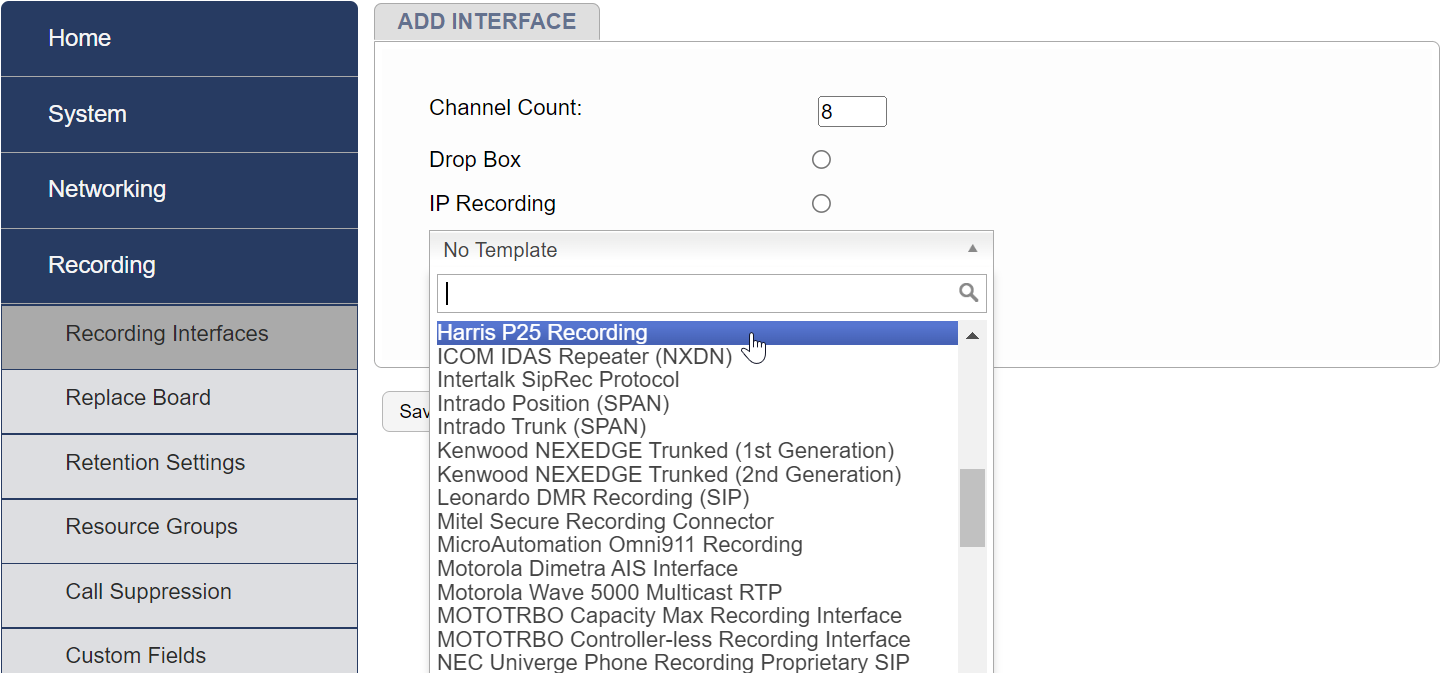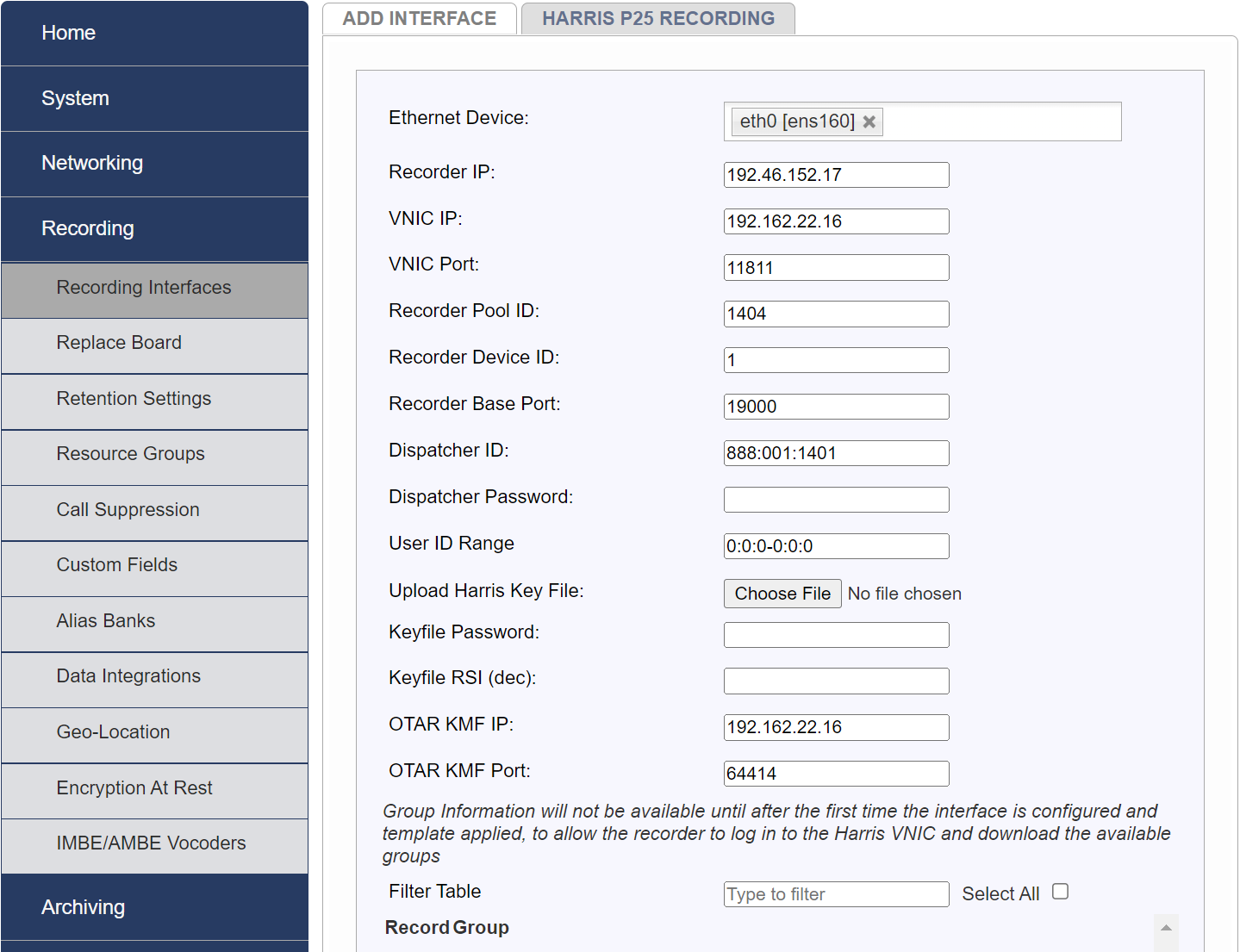6.8. Harris P25 Recording¶
6.8.1. Harris P25 Recording Introduction¶
The purpose of this document is to describe the steps to ensure successful integration between an Eventide NexLog DX-Series and Harris’ VIDA System Release SR10A. The document assumes knowledge of the NexLog DX-Series front panel interface and the browser-based configuration manager and does not discuss recording interfaces beyond the Harris integration. For more details on these interfaces, please refer to their respective manuals.
Required Personnel
Eventide dealer/reseller Technician
Harris Radio System Technologist (ST)
Customer Network Administrator
Eventide support/deployment engineer
License Required
This feature must be licensed to be used for the following:
VOIP/RTP VoIP Channels
P25 decryption (if Crypto is being used)
OTAR functionality (if OTAR is being used)
Harris P25 Integration
Contact your Eventide Communications Dealer for assistance.
6.8.2. Adding a Virtual Recording Interface¶

Fig. 6.75 Add Virtual Recording Interface¶
Select the number of IP channels/number of talk paths and “Harris P25 Recording” Template

Fig. 6.76 Select Channels and Template¶
6.8.2.1. Template Field details¶
The following figure has the fields populated for illustrative purposes, however, the actual values in each installation will most likely be different. Verify each value with the Harris ST or the Customer Network Administrator.

Fig. 6.77 Template Field Details¶
Ethernet Device: Select the physical Ethernet/NIC of the recorder which is connected the Harris VIDA LAN switch
Typical Source: Customer Network Administrator
Recorder IP: IP address of the recorder
Typical Source: Customer Network Administrator
VNIC IP: IP address of the VNIC on the VIDA Network which will be the interface to the recorder
Typical Source: Harris ST
VNIC Port: UDP port on which the NexLog DX-Series and VNIC will exchange control data during initial and subsequent configuration (Typically this is 11811)
Typical Source: Harris ST
Recorder Pool ID: Unique recorder pool ID on the VNIC available for the recorder
Typical Source: Harris ST
Recorder Device ID: Unique recorder device ID on the VNIC designated for the recorder (usually 1)
Typical Source: Harris ST
Recorder Base Port: Base/Starting UDP port on which the NexLog DX-Series will look for recording data (default 19000, unless otherwise advised, leave at 19000)
Typical Source: Eventide support/deployment engineer
Dispatcher ID: Dispatcher ID within the VIDA environment that has access to all talk groups to be recorded
Typical Source: Harris ST or Customer Network Administrator
Dispatcher Password: Password of the above ID
Typical Source: Harris ST or Customer Network Administrator
User ID Range: Range of Radio User IDs that will be recorded during “I-calls” (defaults is “0:0:0-0:0:0”, meaning all, leave as the default unless otherwise informed)
Typical Source: Harris ST
Upload Harris Key File: The crypto key file must be supplied by the Harris ST or Customer Network Administrator if any encrypted recording is required, regardless if OTAR will be used
Typical Source: Harris ST or Customer Network Administrator
Key file Password: Password required to unlock the above Key File. If the key file is unencrypted, the password field is left blank
Typical Source: Harris ST or Customer Network Administrator
OTAR KMF IP: IP address of the Key Manager Facility (KMF) which manages Over The Air Rekeying (OTAR), leave blank if OTAR will not be used
Typical Source: Harris ST or Customer Network Administrator
OTAR KMF Port: UDP port over which the Key Manager Facility (KMF) will communicate to the recorder, leave blank if OTAR will not be used
Typical Source: Harris ST or Customer Network Administrator
6.8.2.2. Apply the template¶
After filling in all the fields, select “Save”. The NexLog DX-Series will now attempt to contact the VNIC and download the available talk groups to the recorder.
Note
Setup time can take anywhere from 3 seconds to more than a couple of minutes to return the available talk groups for recording, depending on the amount of data being returned. If the template does not return any talk groups, this must be resolved before proceeding further.
There are several reasons why the talk groups may not be returned:
VNIC IP not visible to the NexLog DX-Series, verify firewall settings with Harris ST
UDP Ports between the recorder and VNIC are being blocked by the firewall
Incorrect Dispatcher ID and/or password, verify with Harris ST
Select the desired talk groups and “Reapply Template”
6.8.2.3. Check for Alerts¶
Check the NexLog DX-Series front panel and/or configuration manager (figure below) for any system alerts or Harris-specific alerts. There will be alerts specific to the Harris integration if there are problems with downloading talk groups, managing crypto keys, and OTAR.
6.8.2.4. Verify Recording¶
Place a series of test calls between radios on both encrypted and unencrypted talk groups. Use MediaWorks DX or the front panel display to verify the recording of all test calls.